
Take Your Production to the Next Level: Photo vs. Cinema Lenses
From size and weight to price range, let’s examine the pros and cons of the photo lens versus the cinema lens.
You may have shopped around B&H a few times and noticed a different classification of lenses—cinema lenses. What makes these lenses so different from the photography lenses you’re used to? Why are their apertures listed in T-stops and not F-stops? Plus, why are they so dang expensive?
Should you think about getting into these lenses? Let’s break it down!
What Is a Cinema Lens?

Cinema lenses are pretty much what the name suggests. These lenses are built for shooting movies or high-end videos. Standard lenses are built for photography and have been co-opted for video, whereas cinema lenses are built from the ground up with the features for a film set in mind.
You’ll find many features and differences between the two different styles of lenses—everything from the size and weight to the materials and mechanics. Manufacturers create photography lenses for easy use by a single person who operates the camera and adjusts the necessary functions of a lens. On a lot of professional movie and video sets, you’ll have a small team of two or more people working in unison with hands on the camera. During any given take, one person may handle the focus while another manages the framing, and possibly someone else adjusts the exposure.
This can get even more complicated if you involve special effects, gimbals, steadicams, or drones. This is where the specialty cinema lenses come into play.
Size
With a quick glance at a cinema lens, you’ll notice a big difference right off the bat. Some cine glass can be gargantuan. Most cinema lenses are much larger than their photography counterparts. Cinema lenses also use higher quality materials, such as an all metal casing, much larger glass elements, and materials made to last years, if not decades.
The standard 50mm prime you’re used to shooting still with may come just a few inches off the camera, Meanwhile, a cinema version could be four inches or longer and weigh a few pounds. This larger size and weight isn’t just to scare away smaller, lighter lenses with intimidation. Cine lenses are built to last and take a beating. The larger housing is a bit more rugged and can stand the test of a difficult film set.
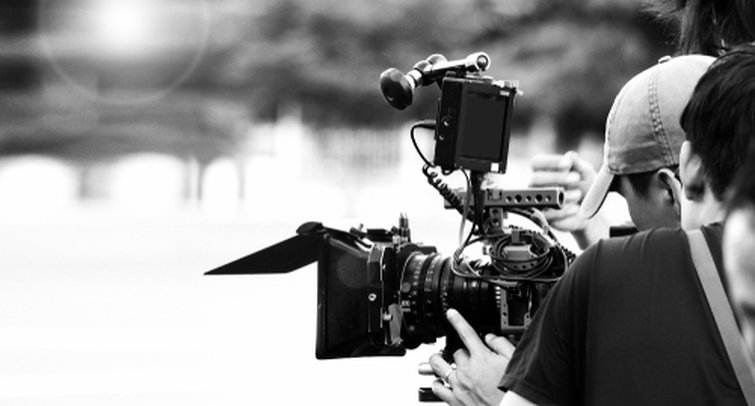
Cinema lenses that are made as a part of a set will also all be sized similarly. When the crew needs to change a lens, a lot of the gear attached to the lens will need to be moved, reattached, or adjusted. If all the lenses, gears, and filters match up perfectly between lenses, all the accessories attached can go right back to where they were with the previous lens.
Focus
Size also comes into play with the focus operations of a cine lens. It’s easy to notice the large geared rings alongside a cine lens. These rings directly operate the focus and aperture.
You’re probably familiar with the focus ring on any lens you have. In case your auto-focus isn’t quite hitting the mark, you can make little adjustments manually to lock it in where you’d like.
Unlike photo lenses, cinema glass doesn’t have autofocus capabilities. The focus is handled directly by a person, which gives the operator the flexibility to change the focus on the fly and hit the marks they need to. If you’ve ever tried to manually focus a photo lens, you may have also been able to cover the entire focus range with just a couple dozen degrees of motion—going from minimum focus distance to infinite in a quick flick of the wrist. The large focus throw of a cine lens allows the focus-puller to make the smallest changes and finesse the focus as needed. This large focus throw also affects the size of the lens. You need larger housing for a wider throw.
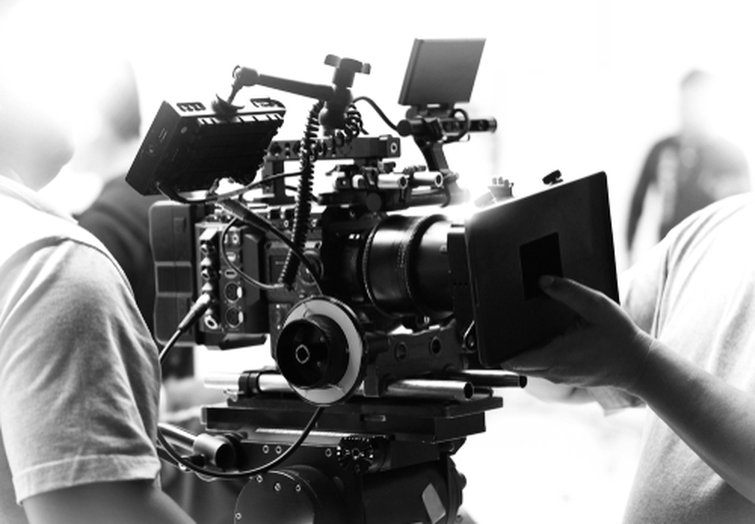
Aperture
A crew member on set will also control the aperture, as mentioned above. Rather than having the camera itself control the lens’s aperture setting—like on your DSLR—it’s controlled right on the lens itself. Additionally, instead of having hard increments like 2.8, 3.5, 4, the aperture ring will be “declicked” and have a smooth operating motion. Now, you’ll be able to fine-tune the exposure rather than the lens limiting you to hard stops.
You’ll also see markings on the lens that indicate the current level of opening. This is where the unique T-Stops come into play. T-stops are similar to F-stops on a standard photo lens. They’re referring to the same mechanism—the aperture—but in two different ways. F-stop strictly refers to the size of the opening in reference to the lens’s focal length. The “T” in T-stop refers to the amount of light actually transmitted.

Pricing
Ready yourself for some serious sticker shock if you’re comparing the typical price range of professional photo lenses versus what you can find on a Hollywood film set. A set of primes in Sony’s G-Master line might set you back a few thousand. Not cheap, but a common price range for professional quality glass. A set of cinema lenses from Zeiss could be worth more than a home in most of the U.S.
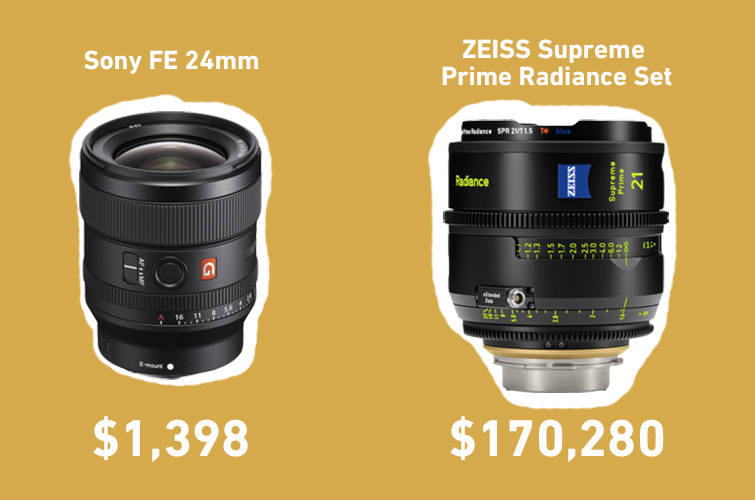
The cost of Hollywood level glass is high for a few reasons. As mentioned above, the size and materials used to make these lenses is of much higher quality and size than your typical photo lens. In turn, this makes these lenses inherently more expensive to produce.
A portrait lens might have a great lifespan of a few years and last you multiple body upgrades. However, cinema-level glass can last decades and is expected to be a workhorse. Many of the higher-end (they get even more expensive) kits may not even be available for purchase. Commonly, film productions simply rent the lenses they need for the duration of the production period, rather than outright purchasing them.
In this YouTube video, Potato Jet breaks down what really goes into an ARRI lens with an ARRI Lens Specialist.
Supply and demand is another factor into their extreme scales of pricing. The standard 50mm F/1.8 from any lens manufacturer may see hundreds of thousands (if not millions) of units produced and sold. High-end cinema lenses, on the other hand, may only see a few hundred (or maybe a dozen) units produced. With a ton of investment to make these levels of lenses the highest quality they can, the high price point makes sense to ensure a return on the production.
Where to Start
Maybe you’re considering getting your own set of lenses to take your film gear up a notch, or because you want to get started in film production. Don’t let the big lenses and their outstanding prices scare you. You still have some options.
Remember, the best lens is the one you have on you.
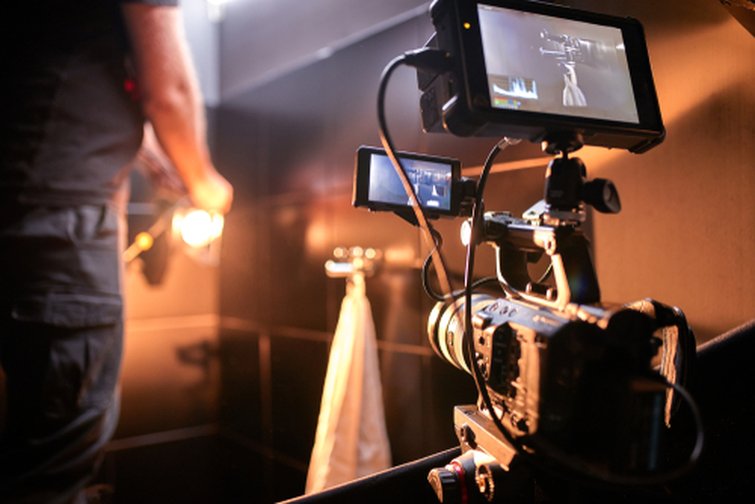
Consider sticking with your current lenses if they’re working for your conditions. It’s true that cinema lenses get their value when ease of use, ability to transition, and the highest quality possible is important. Don’t let that stop you from seeking some of the same benefits, though. There are some ways you can adapt your current lenses.
Firstly, try adapting your current lenses with geared rings. This will allow you to pull focus with a follow-focus attachment and have a dedicated focus puller when needed. You can find these neat accessories in various fitting solutions. Some manufacturers have pre-designed rings to fit the exact lens you’re looking to adapt, or you can grab a one-size-fits-all solution that can be sized to almost any lens needed. Sometimes, these one-size versions can have a little “geared tail” that can get in the way. I’ve simply taken some scissors and snipped it away to cut down on the clutter.
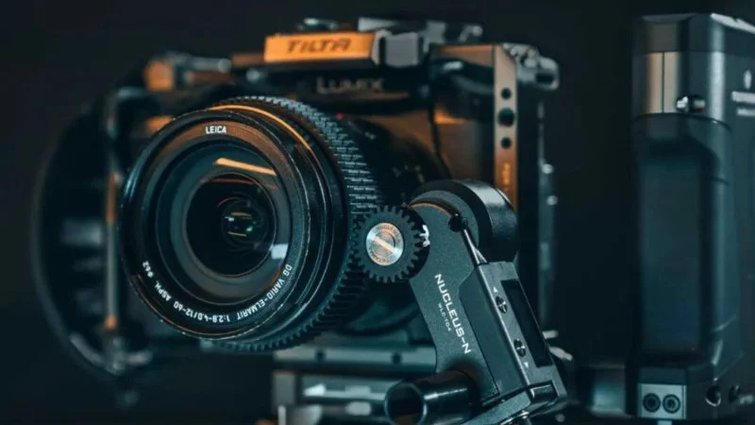
There’s also the option to adapt your entire lens with new housing into a cinema lens. This isn’t an easy, at-home solution. You’ll need to send off your lenses to the company adapting the glass and wait for the manufacturing time it takes to completely rehouse and adapt the lens.
This route doesn’t come without its downsides. Adapting a prebuilt lens isn’t cheap, and may make more economic sense to simply purchase a different lens. Additionally, you’ll have the downtime without a lens for the weeks or months it takes to make the change. Typically, that’s not time we have to give up.
Budget Versions
With the huge rise in the budget-minded filmmaker, the market for more economical solutions has sprouted and even made its way into cine lenses. Now you can find cine lenses anywhere from a few hundred dollars each to just a few thousand, and everywhere in-between. Many of these lenses are similar photography lenses reworked with a cine-like housing, and will perform similarly. For instance, Rokinon’s cine line of glass is simply their standard, all-manual lenses with new housings and upgraded materials. Finding a new set of cine lenses to fit your budget, workflow, and production is now easier than ever.
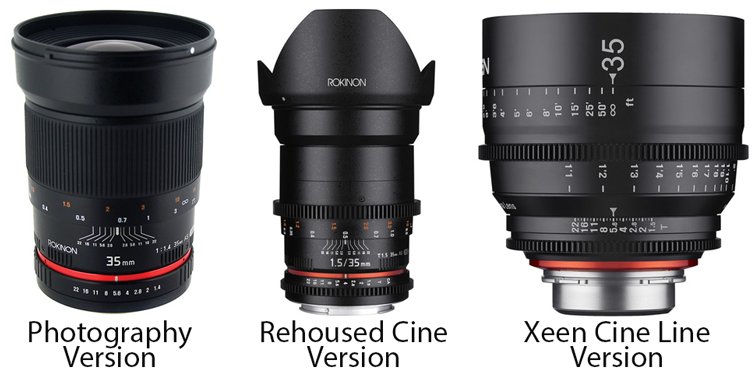
Compounded by the fact that micro four-thirds is also a popular frame size, making cinema lenses to fit this small form factor also cuts back drastically on their pricing since you’re only needing to cover a smaller sensor profile. You can purchase a Meike cinema lens, only available for MFT, for the same price as a standard entry level prime lens ($399). Plus, you can get an entire set for under $1500. If you’re shooting on a Panasonic or a similar small frame camera, this is definitely a suitable way to get started in the cinema glass world.
Photography lenses and cine lenses have a lot in common, but quite a few differences, as well. There’s a reason as to why they’re so large and take a couple people to operate. The world of cinema lenses can be a little deep and daunting but, hopefully, we broke it down for you a bit. If you’re taking a step into video making or want to take your production to the next level, consider our advice on where to start.
Cover image via Alexander Kirch.
For additional filmmaking tips and tricks, check out these articles:
- Filmmaking Gear Highlights of 2020 – Indie Edition
- Film Pacing: 5 Secrets to Keep Your Projects from Getting Stale
- 5 Principles of Documentary Filmmaking to Use on Your Next Film
- Filmmaking Fundamentals: Using Blocking to Get Your Scenes Moving
- The Best Mobile Filmmaking Gear for Making Videos on Your Phone





